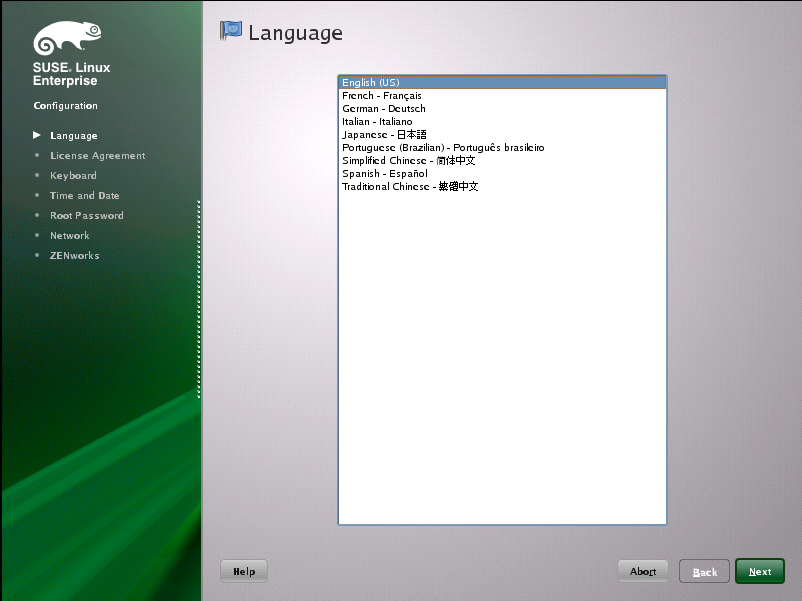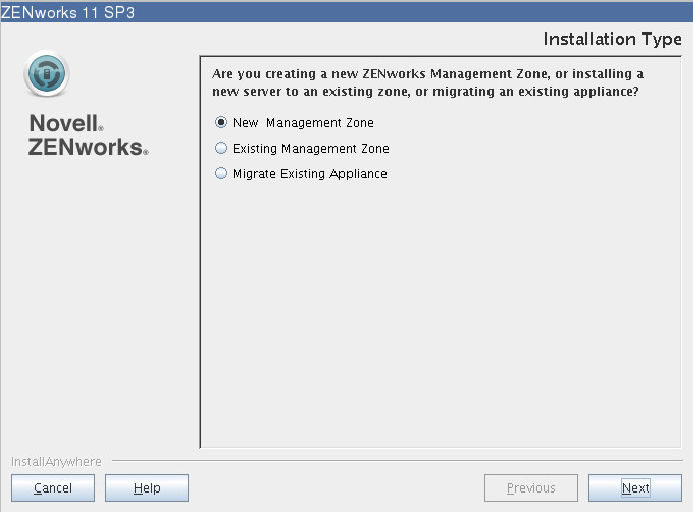3.2 Configuring ZENworks Appliance
After importing the ZENworks Appliance image to your virtual machine, review the following sections to configure ZENworks Appliance:
After ZENworks Appliance is configured, you can log in to ZENworks Appliance and use the ZENworks Control Center management console to access the ZENworks 11 Configuration Management capabilities. For more information, see the ZENworks 11 Administration Quick Start guide.
3.2.1 Configuring the Preinstalled SLES 11 SP3
-
On the Language page of the Configuration Wizard, select the language in which you want the wizard to continue, then click Next.

-
On the License Agreement page, accept the End User License Agreement, then click Next.
-
On the Keyboard page, configure the keyboard layout, then click Next.
-
On the Network Configuration page, select Network Interfaces > Ethernet Network Card > Edit, then configure the following network information for ZENworks Appliance:
-
Host name and server name
The server must have a static IP address or a permanently leased DHCP address.
-
IP address for your machine (for a static IP address)
-
Subnet mask (for a static IP address)
-
Default gateway (for a static IP address)
-
-
On the Timezone page, configure the time zone and clock settings to be used in your system, then click Next.
NOTE:If you are configuring the ZENworks Appliance for the first time, you can configure a primary time source. Later, if required, you can add additional time sources using the NTP mechanism. For more information on synchronizing the system time over a network, see Time Synchronization with NTP.
-
On the Root Password page, specify the root password.
-
Click Finish.
The ZENworks 11 is displayed. This wizard might take a few seconds to launch.
NOTE:If you are configuring the ZENworks Appliance and want to open a virtual terminal during the first boot, press Ctrl+Alt+Space+F2. To return the configuration wizard, press Ctrl + Alt +Space + F7. If you exit from this terminal, you will not be able to open another virtual terminal.
3.2.2 Configuring the Preinstalled ZENworks Server
-
(Conditional) If you have configured ZENworks Appliance with a static IP address, ping that IP address from another machine to test the connectivity.
-
Complete the ZENworks 11 wizard by following the on-screen prompts.

NOTE:
-
If you have cancelled the ZENworks Configuration wizard on Appliance, you can launch it manually by executing the /usr/share/ZCMInstaller/setup.sh -C command on the terminal.
-
During Appliance migration, if there is more data to be migrated than the Appliance’s capacity, you have to cancel the ZENworks Configuration wizard. To increase disk space, see Creating a New Hard Disk. Launch the wizard manually by executing the /usr/share/ZCMInstaller/setup.sh -M command on the terminal.
-
3.2.3 Configuration Information for ZENworks 11 SP3 on ZENworks Appliance
The information you need is listed in the order of the configuration flow of the ZENworks 11 SP3 Wizard.
Table 3-1 Configuration Information
|
Wizard Page |
Details |
|---|---|
|
Management Zone |
New Zone: If you are deploying to the first server in the zone, you need to know what name you want for the Management Zone and what you want to use for the zone’s password, which is used for logging in to ZENworks Control Center. The zone name has a 20-character limit and should be a unique name. We recommend the zone name to contain minimum six characters. The zone name can contain only the following special characters: - (dash) _ (underscore) . (period). The zone administrator password must contain at least six characters and is limited to a maximum of 255 characters. The password can contain only one instance of the $ character. By default, the login username is Administrator. After completing the deployment, you can use ZENworks Control Center to add other administrator names that can be used to log in to the Management Zone. During the deployment of the second (or subsequent) Primary Server, the server by default uses the ports used by the first Primary Server. If the ports are in use on the second Primary Server, you are asked to specify another port. Note which port you specify because you need to use it in the URL for accessing ZENworks Control Center. Existing Zone: If you are deploying to an existing Management Zone, you need to know the following information:
|
|
Database Information |
For ZENworks 11 , a database must be installed. The database options are displayed only during the first server installation in the zone. However, you can run the installation program specifically to install or repair a database (see Installing an External ZENworks Database in the ZENworks 11 SP3 Server Installation Guide). You have the following database options:
IMPORTANT:For external databases, the server hosting the database must have time synchronization with each of the Primary Servers in the Management Zone. |
|
Database information |
For the external database options (Remote Sybase SQL Anywhere, Microsoft SQL Server, and Oracle), you need to know the information listed below. Defaults are provided for some of this information, which can be changed as necessary.
|
|
Database access |
For the external database options (Remote Sybase SQL Anywhere, Microsoft SQL Server, and Oracle), you need to know the information listed below. Defaults are provided for some of this information, which can be changed as necessary.
|
|
SSL configuration (shown only for the first server installed in the Management Zone) |
In order to enable SSL communications, an SSL certificate must be added to the ZENworks server. Select whether to use an internal or external certificate authority (CA). For subsequent deployments of Primary Servers to the Management Zone, the CA established by the first server’s deployment is used for the zone. The Restore Default buttons restore the paths to those that were displayed when you first accessed this page. |
|
Signed SSL certificate and private key |
To enter a trusted CA-signed certificate and private key, click Choose to browse for and select the certificate and key files, or specify paths to the signed certificate to be used for this server (Signed SSL Certificate), and the private key associated with the signed certificate (Private Key). For subsequent deployments of Primary Servers to the zone, the CA established for the zone by the first server’s deployment is used. For information on creating external certificates to select, see Creating an External Certificate in the ZENworks 11 SP3 Server Installation Guide. For information on creating external certificates for deploying to a server using a silent installation, see |
|
Root certificate (optional) |
To enter a trusted CA root certificate, click Choose to browse for and select it, or specify the path to the CA’s public X.509 certificate (CA Root Certificate). |
|
License key for ZENworks Configuration Management, ZENworks Asset Management, and ZENworks Asset Inventory |
By default, the Evaluate check box is selected for all the ZENworks 11 products listed on the page. The products include:
If you choose to retain the default settings, all the products are installed with a 60-day trial license. Additionally, you can choose to do any of the following:
|
|
License key for ZENworks Patch Management |
The ZENworks 11 Patch Management software is automatically installed. However, the product is activated for patch downloads only if the following conditions are met:
You can activate the subscription service later through ZENworks Control Center. For more information, see the ZENworks 11 SP3 Product Licensing Reference. If you specify the license key, you must additionally specify the company name and the e-mail address. If you do not want to install ZENworks 11 Patch Management, manually deselect the Activate check box and do not specify the license key for the product. The product is automatically installed; however, it is deactivated. |
|
Pre-installation summary |
To make changes to any information entered up to this point, click Previous. After you click Install, the configuration begins. |
|
ZENworks System Status Utility |
Allows you to launch a ZENworks services heartbeat check prior to closing the configuration program. Results are posted in the installation log. |
3.2.4 Installing the VMware tools on a ZENworks 11 SP3 Virtual Appliance
By default, the VMware tools are installed at the first boot of ZENworks SP3 Virtual Appliance, based on the virtual environment of the host.